Travel: How a £525 bet gave birth to your morning commute
It wasn't in bustling London, busy Berlin or even crowded Tokyo - the birth of your morning commute wasn't even in a major city.
It started high in a Welsh valley when the Elon Musks and Mark Zuckerbergs of the 19th Century bet on whether you could make a rail locomotive move on its own.
History was made in 1804 when Cornish inventing pioneer Richard Trevithick's engine moved on tracks under its own steam.
"It was a moment that changed the world forever," said TV historian Dan Snow.
The origins of the Orient Express, Trans-Siberian Railway, Hogwarts Express and Thomas The Tank Engine can be traced back to Trevithick's modest locomotive that is regarded by experts as the world's first railway engine.
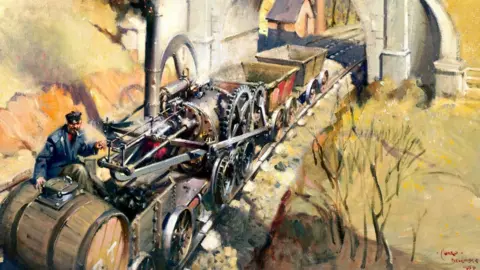 Getty Images
Getty Images"Up until that point, nearly everyone lived and died within 30 miles of where they were born and the fastest anyone could go was the speed of a galloping horse," added Snow.
"Look at the world now. Many have families in other counties, people have married people from different parts of the world, you work alongside people from all over the world - we're taken to work in trains, buses, cars and even aeroplanes.
"It was an extraordinary moment for the human race, a massive technological breakthrough. That revolution began in Merthyr Tydfil.
"The best thing is he does it in response to a bet between the wealthy entrepreneurs, the Elon Musks and Mark Zuckerbergs of the day," said Snow.
 Getty Images
Getty ImagesWhat was the first railway engine?
Trevithick had already pioneered high pressure stationary steam engines for mining and driving machinery and Welsh iron entrepreneur Samuel Homfray bought shares in his patent and brought him to his works in Merthyr Tydfil.
"Trevithick had already created an engine called the Puffing Devil in 1801, which was basically a steam train on the road that moved under its own power," said Snow.
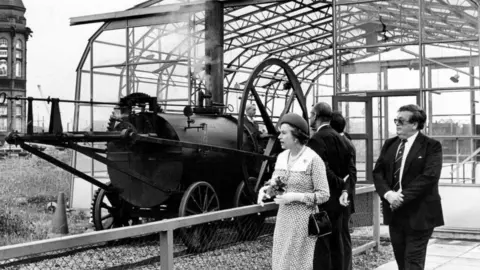 Getty Images
Getty Images"But it caught fire and was destroyed, so that didn't really work. He'd got static steam engines working but dreamed of making wagons move without horses."
Homfray encouraged Trevithick to put a steam-powered engine onto a rail-mounted locomotive to travel over newly laid tramroad from his works at Penydarren to a canal wharf at Abercynon nine-and-three-quarters-of-a-mile (16km) away - so Homfray's iron could be shipped from there around the globe quicker.
Richard Crawshay, a rival ironmaking baron in Merthyr, was apparently sceptical about the new engine so he and Homfray placed a 500 guineas wager - or £525, which was then an estimated lifetime earnings - on whether it would work.
When did the world's first railway locomotive run?
After about 12 months of building, Trevithick's ground-breaking unnamed five-tonne locomotive carried 70 people and 10 tons of iron along the banks of the River Taff down the valley to Abercynon on 21 February 1804.
 Getty Images
Getty ImagesTrevithick said afterwards: "We proceeded on our journey with the engine... the engine, while working, went nearly five miles an hour; there was no water put into the boiler from the time we started until our journey's end... the coal consumed was two hundredweight".
On the return journey, a bolt sheared on what is now more widely known as the Penydarren loco, causing the boiler to leak.
The fire had to be dropped so the engine did not get back to Merthyr until the following day.
The ground-breaking locomotive was also rail-breaking too as it was so heavy it broke the rails of the tramroad and was later converted into a stationary engine that drove a forge hammer at Homfray's Penydarren works.
"Nevertheless, Trevithick proved a locomotive could not just move itself but could pull viable load a significant distance," said Museum Wales' Principal Curator Jennifer Protheroe-Jones.
"It also silenced doubters who felt that smooth iron wheels wouldn't be able to grip smooth iron track but Trevithick showed that it could.
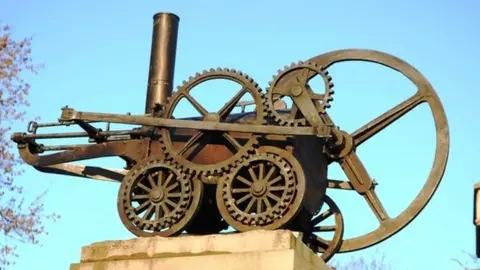 Ray Jones | Geograph
Ray Jones | Geograph"It really was the beginning of a revolution in rail transport. The Penydarren loco is the great grandfather of all railway locomotives as those primitive beginnings was where it all began."
Why was the first railway locomotive in Wales?
Wales is regarded as one of the world's first industrial nations and south Wales was the heartbeat of the revolution and centre of innovation, mining coal in the valleys and shipped around the globe.
"Something extraordinary was happening in Wales 200 years ago when it basically became the world's first region to industrialise - and it would change the world," said Snow.
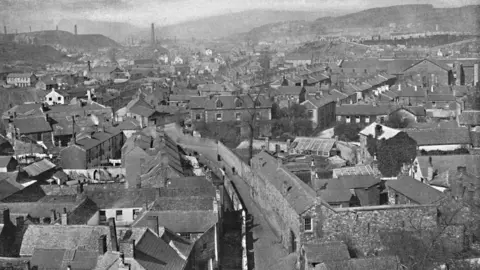 Getty Images
Getty Images"The way that we all live now - in our factories, our commutes, our mechanised lives, working in globalised industries, all begins in Wales and the West Midlands."
Merthyr Tydfil was the centre of iron production and by the early 1800s was Wales' most populated town.
Workers from around the world, including Trevithick, came to work in the ironworks.
"Wales was one of the great crucibles of the Industrial Revolution, which was sweeping Europe and later the world," added Ms Protheroe-Jones.
"Swansea was the world centre for copper making, Wales was the centre of world for tinplate and and iron production - so big things were happening here and inventors were coming to develop their ideas. Wales, at that moment, was one of the great centres of technological advance."
Who built the world's first railway engine?
Even though Trevithick invented the world's first railway locomotive, George Stephenson is widely regarded as the father of the railway.
Stephenson built the first steam locomotive to carry passengers on a public rail line - the Stockton and Darlington Railway - in 1825, before opening the world's first public intercity railway line, the Liverpool and Manchester Railway, five years later.
"Stephenson perfects the idea of a railway, from start to finish," said Snow.
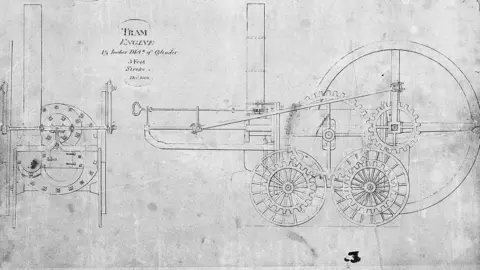 Science & Society Picture Library
Science & Society Picture Library"Not just the engine running on it but he invented the tracks, the signals, the protocols - he invented intercity rail travel.
"That's why he's remembered as the father of the railways but Trevithick is certainly the grandfather."
Trevithick, the son of a mine manager, did not have an academic background, but displayed intuitive engineering talent which has seen historians describe him as a maverick.
"Trevithick didn't have such good publicity as Stephenson, who was an excellent self-publicist," added Ms Protheroe-Jones.
 Nantcoly | Geograph
Nantcoly | Geograph"But his achievement more than rivals Stephenson because he demonstrated that a steam locomotive was viable contraption and could be economically useful.
"The developments of Stephenson and all other railway innovations stand on the shoulders of Trevithick, who invented the first steam engine which could move itself and draw a load."
It was one of the many inventions of father-of-six Trevithick but after a number of his business failings, he died penniless and in poverty aged 62 in 1833 and was buried in an unmarked grave.

- MOMENTS, MUSIC AND NOSTALGIA: Wynne delves into the archives of the 1980s
- INSEPARABLE SISTERS: The seven-year-old conjoined twins who defied all odds

